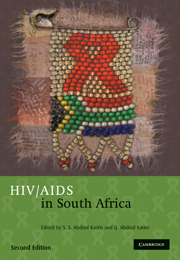Book contents
- Frontmatter
- Contents
- List of Contributors
- Foreword: Peter Piot
- Foreword: Nelson R Mandela
- Acknowledgements
- Section 1 Birth of a rapidly growing epidemic
- 1 Introduction
- 2 Overview of the book
- 3 HIV infection in South Africa: the evolving epidemic
- 4 HIV incidence rates in South Africa
- Section 2 The virus, the human host and their interactions
- Section 3 HIV risk factors and prevention strategiess
- Section 4 Focal groups for understanding the HIV epidemic
- Section 5 The impact of AIDS
- Section 6 Treating HIV
- Section 7 What does the future hold?
- Index
4 - HIV incidence rates in South Africa
Published online by Cambridge University Press: 07 September 2011
- Frontmatter
- Contents
- List of Contributors
- Foreword: Peter Piot
- Foreword: Nelson R Mandela
- Acknowledgements
- Section 1 Birth of a rapidly growing epidemic
- 1 Introduction
- 2 Overview of the book
- 3 HIV infection in South Africa: the evolving epidemic
- 4 HIV incidence rates in South Africa
- Section 2 The virus, the human host and their interactions
- Section 3 HIV risk factors and prevention strategiess
- Section 4 Focal groups for understanding the HIV epidemic
- Section 5 The impact of AIDS
- Section 6 Treating HIV
- Section 7 What does the future hold?
- Index
Summary
TO FULLY UNDERSTAND TEMPORAL changes in the epidemic of HIV we need to know how incidence and mortality have changed over time. Unfortunately, incidence is difficult to measure directly for logistical and ethical reasons and mortality is difficult to measure directly because of the stigma associated with AIDS. Prevalence provides a measure of incidence and mortality averaged over the previous five to ten years so that it is much more difficult to interpret immediate changes in the dynamics of the epidemic using prevalence than it is using incidence. Estimation of HIV incidence is, therefore, essential for understanding the changing dynamics of HIV transmission, as well as for targeting prevention programmes and evaluating the impact of such programmes.
Unlike estimates of the prevalence of hiv in South Africa that are available from several data sources, including antenatal clinic surveillance, population and community based surveys, and studies among specific risk groups, few direct estimates of hiv incidence are available. Indirect incidence estimates have been obtained from mathematical and statistical modelling and from laboratory-based assays.
Several studies have shown very high rates of hiv incidence in South Africa. The unaids sponsored Col-1492 trial measuring hiv incidence rates directly among a cohort of sex workers in KwaZulu-Natal showed an incidence rate of 18% between 1996 and 1998. The incidence rate among young men aged 18–24 years participating in the anrs 1265 male circumcision trial in Gauteng was 1.5% per year between 2002 and 2004.
- Type
- Chapter
- Information
- HIV/AIDS in South Africa , pp. 74 - 84Publisher: Cambridge University PressPrint publication year: 2010
- 1
- Cited by



